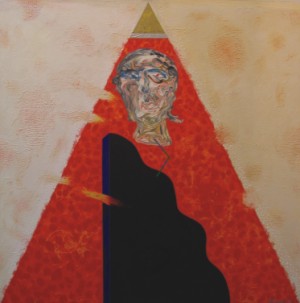|
Art
Reading
the Faces
Mustafa
Zaman

Kalidas
Karmakar, the renowned artist, calls his recent exhibition
"Alluvial Faces 11", although it is addled with
signs of synthesis among cultures. His rhythmic lines recall
both the pictures associated with Zen Buddhism and Islamic
calligraphy. Like a calligrapher, Kalidas too relies on the
power of linearity of his craft.
Most of
the portraits displayed at Gallery Kaya (pronounce kaia) are
what the artist calls "digital lithography". And
they all depict faces constructed in signature Kalidas linear
composition. The coiling that goes with his brush-drawings
is a reminder of the intricacies of his early work. In the
eighties Kalidas used to incorporate such visually interesting
intricate web of thin lines that often helped create an Eastern
ambience in his work. In fact, the tangled, yet the rhythmically
rendered thin lines are a continuation of those Tibetan Buddhist
paintings, where lines play a crucial role.
Even the
symbolism that used to figure prominently in his early works
leads one to the tales of Buddha and a culture of telling
stories using signs; signs that are visual concoctions and
are loaded with metaphysical references. After many years
of delving into a similar kind of whirlpool of amorphous imagery,
in the late eighties the artist settled for more palpable
stuff -- namely, abstraction.
In his
abstractions he brought in handmade object-like elements.
In this solo show, these abstractions, that recall tantric
paintings of Hindu origin, have taken up a lot of space. These
are classic examples of objectification of faith through use
of squires and talisman-like paper-maché elements in
the middle. Those who are familiar with his abstraction may
find these works a little tiring, as stronger works predate
these. But for those who are to encounter them for the first
time, the same pictures will provide a cue to Kalidas' ability
to produce works of visual contemplation. In this line of
works he has always been at ease in displaying his tantric
zeal that has more to do with compositional ploy than with
religious belief. However, he comfortably straddles the fence
between pristine faith and modernist expression, this becomes
obvious after having a look at the flurry of images that draw
on tantric paintings.
The exhibition
"Alluvial Faces II" at Kaya is also about harking
back to the linear possibilities. Though the faces have been
repeated to an extreme degree, there are some visages that
testify to the artist's ability to impose his signature stylistic
grandeur on male or female faces, as in Alluvial Faces-4,
6 and 16.
All of
these faces exude a kind of femininity that is markedly Asian.
Its essence, it seems, has been extracted from the illustrated
myths of Sufi and Buddhist origin.
Most of
his portraits with their distinct goatees and bald heads even
look like Chinese sages. They sometimes resemble the artist.
 The
most visually intriguing works in the present solo are the
ones done in acrylic on paper. These longish works bring into
play a series of roundish forms to create the imagery. In
two of the works the spheres that are often repeated break
into components that, at times, resemble mere brush strokes.
In works like Alluvial Faces -- 30 and 24 the brush-stroke-like
washes are used sparingly. Many of them were lent a new dimension
as the artists attached drawings of human heads. This lends
the otherwise abstract, or should one say, objective composition,
with elements that are loaded with subjective references. The
most visually intriguing works in the present solo are the
ones done in acrylic on paper. These longish works bring into
play a series of roundish forms to create the imagery. In
two of the works the spheres that are often repeated break
into components that, at times, resemble mere brush strokes.
In works like Alluvial Faces -- 30 and 24 the brush-stroke-like
washes are used sparingly. Many of them were lent a new dimension
as the artists attached drawings of human heads. This lends
the otherwise abstract, or should one say, objective composition,
with elements that are loaded with subjective references.
In Alluvial
Faces-26 the interplay between brush-strokes and even spheres
are brought to the fore. The circles are even placed in grids
to create an abstract composition.
The gallery
has one big space and a few smaller rooms attached to the
main space. In the left-hand-corner room, the floor has been
covered with dead, crispy leaves. Right in the middle a mirror
is placed to draw the viewers' attention or to augment it.
With the usual display of two-dimensional images on the four
walls, the ploy of turning the room into a conceptual space
falls flat on the face.
However,
the show is something that is worth visiting. It highlights
all the nuances of the spectrum that Kalidas has developed
over the last four or five years. The paintings in acrylic,
that employ those painterly faces against the backdrops defined
by their rigidly geometric composition, to the portraits and
even to the installation-like presentation using terracotta
sculptures.
The show
that kicked off on December 9, amasses all the ingredients
that Kalidas is made up of. Perhaps that is why it seems like
a 'retro' show -- one that reminds one of the shows that had
preceded it. However, Kalidas is an artist whose works are
worth revisiting even through paintings that may look similar
to the ones that he showed in the last two exhibitions --
one at the Shilpakala Academy few years ago and the other
at the Bengal Gallery last year.
Kaya,
the gallery in Uttara is a newly established art hub, and
a grand one at that. After its opening few months back with
a grand show where even the works of pioneers of Bangladesh
art had featured, it has already showcased a string of exhibitions
that has artistic relevance. The exhibition by Kalidas is
one bright spot on that line of success.
Copyright
(R) thedailystar.net 2004
| 